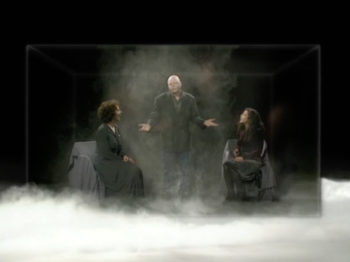
Judith Barry’s All The Light That’s Ours To See
2019 International Exhibition and Performance Fund
Large-scale immersive installations
About the Project
Judith Barry’s work spans a range of media and crosses disciplines, including installation and project-based research, architecture/exhibition design, film/video, performance art/dance, sculpture, photography, and digital media. Her exhibition at Lumiar Cité constitutes the international premiere of her two-channel immersive installation All the light that’s ours to see, for which the artist appropriates the story of a New York video rental chain store, the infamous Mondo Kim’s, and the quest to find a home for 55,000 videotapes and films after it closed. The video rental market generated a transformation in audience viewing conventions that departed from the tradition of a collective experience shared by strangers in the darkness of the cinema and shifted into new domestic uses and spatial typologies – including video games, and evolving social media. This radical change of where we watch and engage with moving images and, consequently, of our sharing and collective experience, gave way to new forms of spatialization inherent to digital media.
A palimpsest of images, presented across two screens, explores how ways of viewing, dating back to medieval times and evolving into our present in a variety of environments, produces different social experiences. Various architectural spaces are represented: from anatomy theaters to libraries and archives, from conventional theatre architecture to churches and the optical illusion of the trompe-l’œil, from factories designed for the performance of new types of labor to museums, from movie palaces to panoramas, from cabinets of curiosities (Kunstkammer) to Renaissance and Baroque painting and their relationship to the development of perspective, sculpture, abstraction, and the moving image. These spaces are explored through a history of technology that considers the relation of older forms to cybernetics, robotics, the Internet, augmented and virtual reality, and artificial intelligence. This visual journey allows the viewer to travel through historical moments and simultaneously question social changes and the relationships between media and our ever-changing habits of consumption. The work is an elegiac meditation on our behavior as audiences and on how we are being transformed by the evolution of new technologies and forms of media ourselves.
Schedule
Past Events
Judith Barry: All The Light That’s Ours To See
September 19–November 22, 2020
Open Wednesday to Sunday, 3pm to 7pm, and by appointment
Reception: Saturday, September 19th, 2020 / 6:00–8:00pm
Online conversation with Judith Barry and Giovanbattista Tusa, moderated by Jürgen Bock: Wednesday, November 18, 2020 / 7:00pm GMT
Associação Maumaus – Centro de Contaminação Visual
Lumiar Cité
Rua Tomás del Negro, 8A
1750-105 Lisbon, Portugal
Biography
Judith Barry is Professor and Director of the Program in Art, Culture and Technology (ACT) at MIT. Barry utilizes a research-based methodology to explore a wide range of topics. Both the form and the content of her work evolve as the research proceeds. She often makes use of installation, in various forms, as a way to combine many of her disparate interests. These immersive environments are based on experiments incorporating architecture, sculpture, performance, theater, film/video/new media, graphics and interactivity.
Barry has exhibited internationally at such venues as the Berlin Biennale, Carnegie International, Documenta, Nagoya Biennale, São Paulo Biennale, Sydney Biennale, Sharjah Biennial, Venice Biennale(s) of Art/Architecture, and the Whitney Biennale, among others. Her awards include the Frederick Kiesler Prize for Architecture and the Arts (2000), “Best Pavilion” at the Cairo Biennale (2001), and a Guggenheim Fellowship (2011). Public Fantasy, a collection of Barry’s essays, was published by the ICA in London (1991). Other publications include Projections: mise en abyme (1997), The Study for the Mirror and Garden (2003), and Judith Barry: body without limits (2009).
More at the artist’s website: Judith Barry
In the Media
Umbigo Magazine: All The Light That’s Ours To See, by Judith Barry
TV Europa: (in Portuguese) Lisboa recebe “All the light that’s ours to see” de Judith Barry em estreia internacional
Jornal Público: (in Portuguese) Exposições: 55,000 filmes e mais algumas imagens
The Boston Globe: A multimedia artist attuned to the zeitgeist







